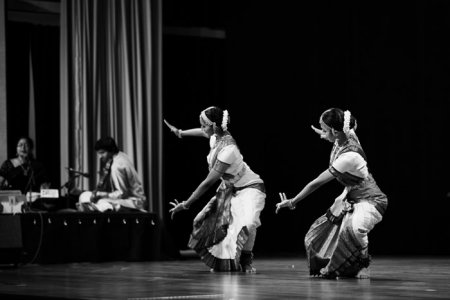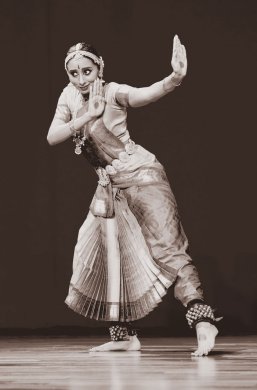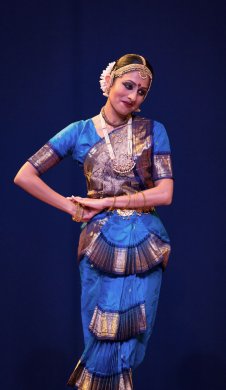
|   |

|   |
 e-mail: leelakaverivenkat@gmail.com Bharatanatyam duo at California's Chinmaya Mission July 19, 2016 It was for me intriguingly unlike the usual run of programmes watching a recital titled 'After Arangetram' in California's Irvine district - for it was after more than a decade that I was witnessing Bharatanatyam in the States, by dancers from Arpana, an established school in Irvine, run by Ramya Harishankar. It was that unmistakable Indo-American ambiance at the Los Angeles Chinmaya Centre auditorium, notwithstanding saree-clad volunteers ushering in ticket holders (unlike the Indian situation where most programmes are for an invited audience.  Visalini Sundaram & Kanthi Atreya What I found interesting were the references to dance history and the introductory statements to individual items by the respective dancer, the articulate ease and the confidence, of course, very American. The organizational detailing included a printed glossary of terms from A to V (Varnam) distributed to the audience, along with bio-data sketches of the Guru, the dancers, the musicians and of course the entire programme with one line descriptions. The introduction to Bharatanatyam (to help a mixed audience) assertively described the dance as a combination of "bhava, raga, tala" based on the Natya Sastra! (Every tradition can trace some aspects to the N.S and what about the regional identity?). The other quaint observation was that the anti-nautch movement in the North of India influenced the South too causing the move against professional dancing women. Muthulakshmi Reddy would not appreciate being told that her movement to stop girls being dedicated to a life of temple dancing was guided by what the North Indians felt! If one expected any avant-garde approach designed on contemporary western thinking on the subject of the traditional dance and its practitioners, it was not evident, given the usual undercurrent of romantic spirituality. The Americanisms for me were in the typical turn of phrase - as in the description of the khanditha nayika's confrontation with her faithless lover in the Jaavali "Muttavaddu ra" in Saveri (presented by Kanthi) that he seemed to have "established some chemistry with that other woman. Go to her. Do not come to me."  Visalini Sundaram Visalini Sundaram presenting Purandaradasa's "Chikkavane Ivanu" took my mind back to thirty years ago when I had watched Ramya Harishankar, a disciple of Swamimalai Rajaratnam Pillai and Kalanidhi Narayanan present this same Padam, and having watched innumerable dancers over the years, I have yet to see somebody improve on her interpretation of the Gopi baffled by the child/man Krishna.  Kanthi Athreya Athreya's presentation of the Purandaradasa composition "Jagadoddharana" stressing the wonder of Krishna, the Lord of the Universe - perhaps lost sight of the sub-text of the poet's wonderment that Yashodhara as foster mother had merited the extraordinary blessing of bringing up this God child - who she regarded as her own son "Maganendu tiliyuta" - denied to the biological mother Devaki. Also here is the cheek-by-jowl micro manifestation of Yashodhara's darling child against His macro manifestation as creator and protector of the Universe (Jagat udhaarana). Where one could close one's eyes forgetting that one was away from India, was in the excellent musical accompaniment for the dance. Asha Ramesh, a disciple of maestro D.K. Jayaraman and Nanganallur V. Ramanathan provided evocative vocal support. Kiran Athreya's (disciple of Delhi P. Sunder Rajan) clear toned melodic violin interventions added much to the music. And the surprise packet for me was the female mridangist Shubha Chandramouli, a disciple of Poovalur Srinivasan, whose nimble fingered percussion clearly etched out every syllable of the jatis and the tala, an expertise flowing from her also being a Bharatanatyam dancer and a vocalist. As a matter of fact, classical Carnatic music has a good following today in the States. The real lack is in in-depth research into poetry and literature of the vernaculars forming the textual material for the dance. Learning Indian dance is serious cultural duty in the States and doting mothers and grandmothers drive long distances to take their children for weekly dance lessons at Arpana. Watching countless tiny tots do their adavu-s in brightly coloured 'pavadai-s' was a delight and one appreciated the group discipline and the tremendous effort and planning going into putting so many children on the stage, along with senior disciples of Ramya, Anusha Kedhar and Akhila Gulasekharan. The sights and sounds of a culture in which Bharatanatyam forms a natural way of expression, is what most American children miss - unless born to a home where the sounds of mantras, of Carnatic music and of spoken south Indian languages is natural. We know of the Mythili Prakashes who, excepting the foreign accent, do not betray any non-Indian qualities. I do believe that bodies have cultural memory imparting a certain tone and character to every movement. I found youngsters with malleable bodies learning Bharatanatyam - and while the dance lines and profile were perfect, when the cultural mindscape accompanying movement was different, the result at times was like gymnastics and away from how conditioned minds visualise Bharatanatyam. Perhaps echoing my thoughts was a remark of a dancer doing a workshop in Chicago, who said to me, "Most of these students who are very enthusiastic don't have Bharatanatyam bodies. They are gymnastic bodies, and the dance becomes, another manifestation of Bharatanatyam." The dance acquires a kind of hybrid vigor.  Writing on the dance scene for the last forty years, Leela Venkataraman's incisive comments on performances of all dance forms, participation in dance discussions both in India and abroad, and as a regular contributor to Hindu Friday Review, journals like Sruti and Nartanam, makes her voice respected for its balanced critiquing. She is the author of several books like Indian Classical dance: Tradition in Transition, Classical Dance in India and Indian Classical dance: The Renaissance and Beyond. Post your comments Please provide your name and email id when you use the Anonymous profile in the blog to post a comment. All appropriate comments posted with name & email id in the blog will also be featured in the site. |